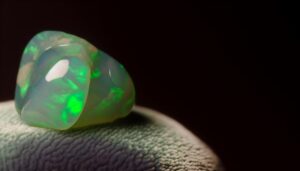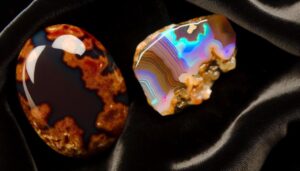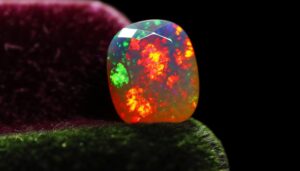Identifying Treated Fire Opals: Step-by-Step Guide
Yes, fire opals are often treated to improve their stability and appearance. Impregnation with resins or oils addresses their natural porosity and fractures, enhancing overall durability and visual appeal.
Heat treatment can intensify their colors and clarity, while precise control during this process is essential to avoid damage. Dyeing techniques like immersion and vacuum dyeing are used to modify or enhance the stone's color.
When buying, consider the type of treatment, its impact on value, and verify ethical sourcing. Understanding these details will help you make an informed purchase.
Investigate further to uncover more insights on these treatments.
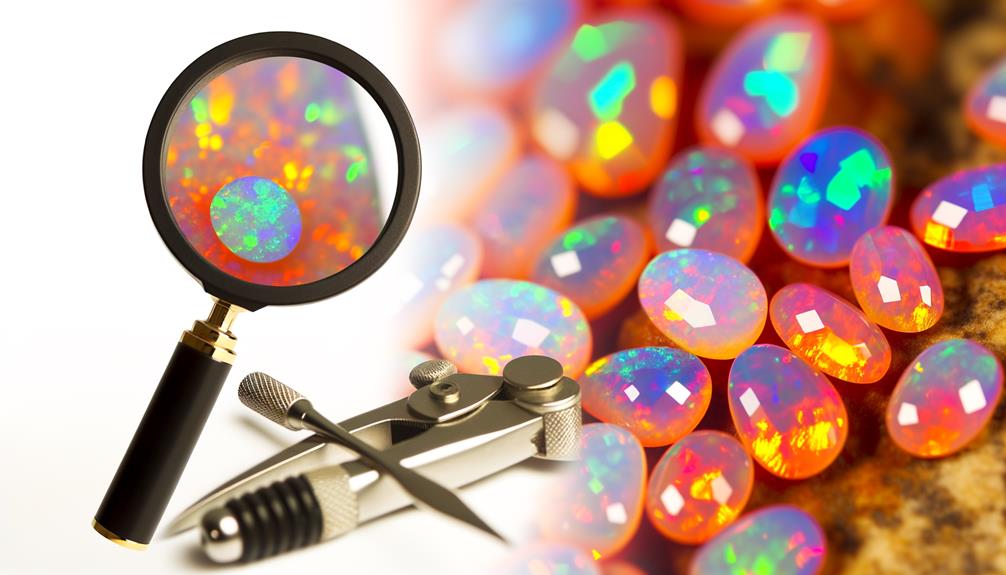
Key Takeaways
- Fire opals are often treated with resins or oils to enhance stability and appearance.
- Heat treatment is used to intensify natural hues and improve clarity in fire opals.
- Dyeing techniques are employed to introduce external colors to fire opals for desired aesthetics.
- Impregnation with resins or polymers fills pores and cracks, reinforcing the opal's structure.
- Treatments like impregnation and dyeing are standard practices in the gemstone industry.
Common Treatments
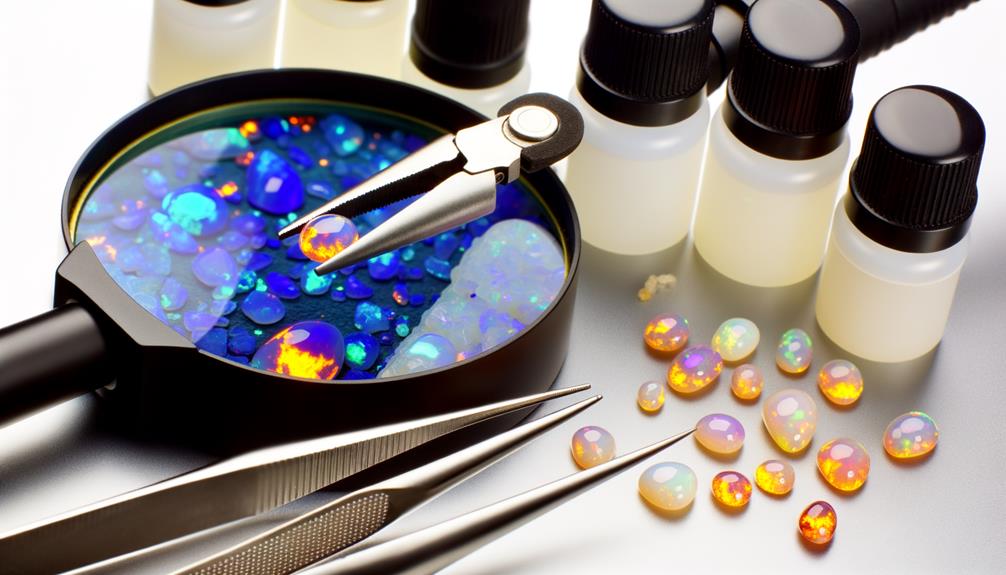
When it comes to enhancing the beauty and durability of fire opals, common treatments often involve impregnation with resins or oils to improve stability and appearance. You'll notice that this method addresses the inherent porosity and fractures in fire opals, making them less susceptible to cracking.
Resins seep into the micro-fractures, solidifying and reinforcing the structure. Oils, on the other hand, enhance the opal's color and luster. Both treatments are widely accepted in the gemstone industry, and they don't typically impact the gem's value significantly.
It's important to know these treatments are standard practices aimed at preserving and enhancing the natural qualities of fire opals, ensuring they remain vibrant and durable for years to come.
Heat Treatment
Heat treatment is occasionally utilized to improve the color and clarity of fire opals, though it requires meticulous control to avoid damaging the delicate gemstone.
You'll find that heat treatment can:
- Enhance Color: It can intensify the opal's natural hues, making the stone more visually striking.
- Boost Clarity: By reducing internal inclusions, the gemstone becomes clearer and more appealing.
- Strengthen Durability: Proper heat treatment can sometimes make the opal more resistant to cracking.
It's important to maintain precise temperature control since overheating can cause the opal to fracture or lose its vibrant color.
Additionally, you should always verify if a fire opal has undergone heat treatment, as this can affect its value and care requirements.
Dyeing Techniques
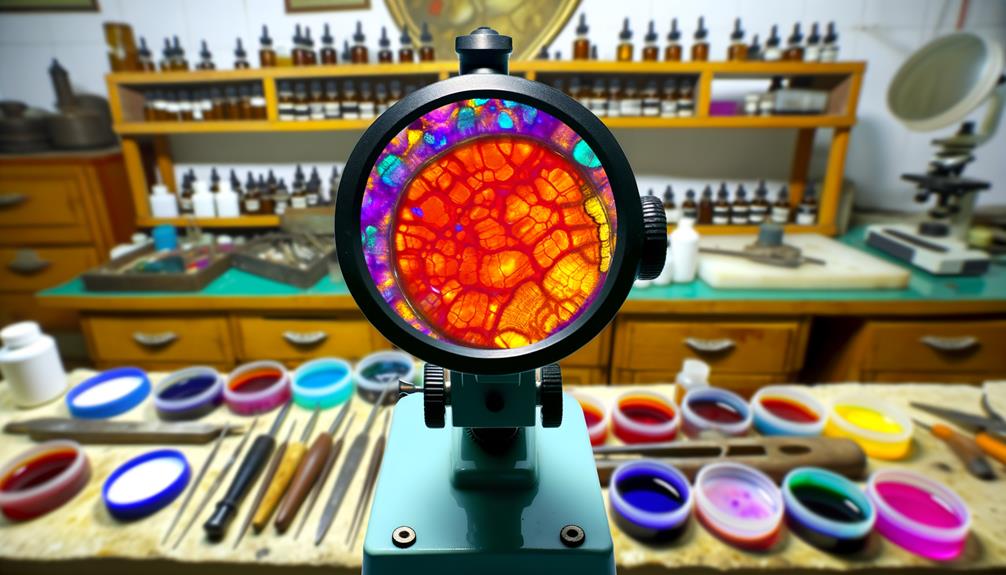
While heat treatment focuses on enhancing a fire opal's natural properties, dyeing techniques involve introducing external colors to the gemstone to achieve a desired aesthetic. You can dye fire opals through submersion in chemical solutions that penetrate the stone's porous structure, altering its color. This process requires meticulous control to guarantee uniformity and stability of the color.
Here's a breakdown of common dyeing techniques:
| Technique | Description |
|---|---|
| Immersion Dyeing | Submerging opals in dye solutions for even coloring. |
| Surface Dyeing | Applying dye to the stone's surface for quick results. |
| Heat-Assisted Dyeing | Using heat to facilitate deeper dye penetration. |
| Vacuum Dyeing | Employing vacuum to enhance dye absorption. |
Impregnation Process
The impregnation process reinforces a fire opal's durability by filling its pores and cracks with a stabilizing substance. You'll typically see resins or polymers used for this purpose. This method enhances the stone's structural integrity, making it more resistant to damage.
Here's how the process works:
- Cleaning: The opal is meticulously cleaned to remove any debris or impurities.
- Vacuum Chamber: The stone is placed in a vacuum chamber to eliminate air from its pores.
- Stabilizing Substance: A resin or polymer is introduced, which penetrates the opal and fills the voids.
Buyer Considerations
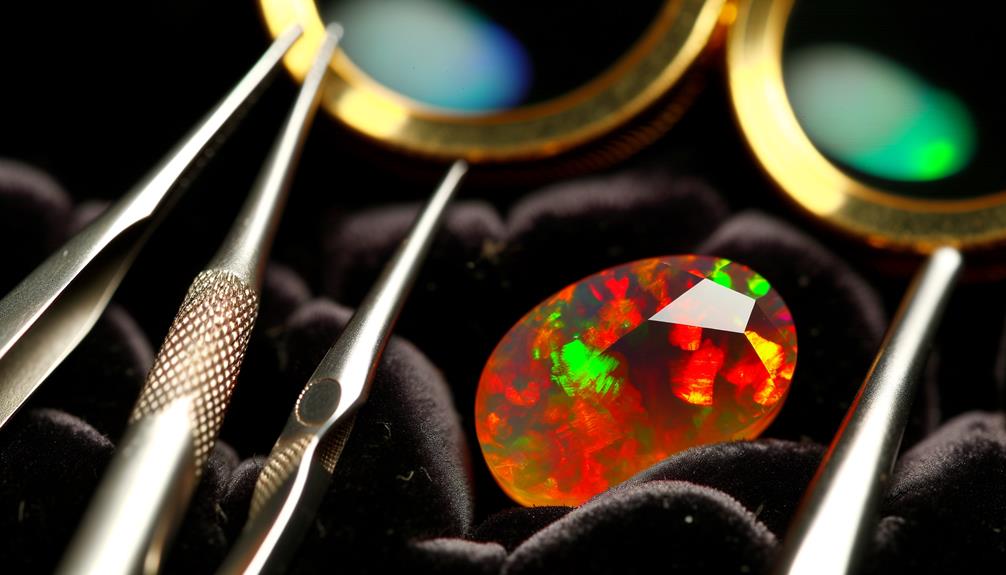
Understanding the impregnation process is key, but you must also consider several factors when purchasing treated fire opals. You need to evaluate the treatment type, durability, and the ethical sourcing of the stones. Additionally, verify the reputation of the seller and request certification to guarantee authenticity. Below is a table to guide you through these considerations:
| Factor | Details | Importance |
|---|---|---|
| Treatment Type | Identify if it's impregnated, dyed, etc. | Determines impact on value |
| Durability | Assess resistance to wear and tear | Impacts long-term usability |
| Ethical Sourcing | Confirm ethical mining and treatment practices | Ensures responsible purchase |
| Seller Reputation | Check reviews and ratings | Indicates trustworthiness |
| Certification | Request gemological certificates | Validates authenticity |
These steps will help you make an informed decision.
Conclusion
In your quest for the perfect fire opal, understanding treatments like heat, dyeing, and impregnation is essential. These processes can enhance beauty but may also impact durability. Remember, knowledge is power—ask questions and request certifications.
Imagine: a gem that not only sparkles but maintains the integrity you desire. By being informed, you guarantee that your chosen fire opal isn't just a purchase, but a lasting treasure.

